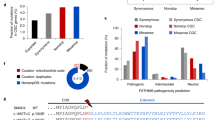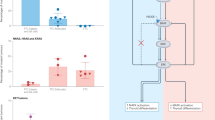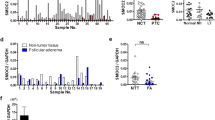Abstract
Sensitivity to transforming growth factor-β is impaired in thyroid tumours. Similar to Mad – Mother Against Decapentaplegic-(Smad)4 is frequently altered in cancers, but its involvement in this system is unknown. We analysed 56 thyroid tumours of various histotypes for Smad4 mutations by PCR-SSCP and sequencing, linking them to Smad4 reactivity as examined by immunohistochemistry (IHC), and 29 of them also for abnormalities in RNA expression due to alternative splicing. In all, 15/56 cases (27%), both benign and malignant lesions, harbour alterations of Smad4 coding sequence. We found several novel intragenic mutations (13 missense, two silent, one frameshift and one large insertion-deletion), with high incidence in the linker region. A subset of mutated tumours failed to express Smad4 protein by IHC. We have also detected four alternatively spliced tumour-associated Smad4 isoforms, lacking portions of the linker region, and three more due to unreported internal exon–exon rearrangements. Smad4 is both frequently mutated and deregulated by aberrant splicing in thyroid tumours and these alterations may contribute as an early event to thyroid tumorigenesis.
This is a preview of subscription content, access via your institution
Access options
Subscribe to this journal
Receive 50 print issues and online access
$259.00 per year
only $5.18 per issue
Buy this article
- Purchase on Springer Link
- Instant access to full article PDF
Prices may be subject to local taxes which are calculated during checkout






Similar content being viewed by others
References
Bai RY, Koester C, Ouyang T, Hahn SA, Hammerschmidt M, Peschel C and Duyster J . (2002). Nat. Cell Biol., 4, 181–190.
Bertaux F, Noel M, Malthiery Y and Fragu P . (1991). Biochem. Biophys. Res. Commun., 178, 586–592.
Blaker H, von Herbay A, Penzel R, Gross S and Otto HF . (2002). Oncogene, 21, 158–164.
Càceres JF and Kornblitt AR . (2002). Trends Genet., 18, 186–193.
Carneiro C, Alvarez CV, Zalvide J, Vidal A and Dominguez F . (1998). Oncogene, 16, 1455–1465.
Colletta G, Cirafici AM and Di Carlo A . (1989). Cancer Res., 49, 3457–3462.
Coppa A, Mincione G, Lazzereschi D, Ranieri A, Turco A, Lucignano B, Scarpa S, Ragano-Caracciolo M and Colletta G . (1997). J. Cell Physiol., 172, 200–208.
Coppa A, Mincione G, Mammarella S, Ranieri A and Colletta G . (1995). Cell Growth Differ., 6, 281–290.
Costamagna E, Garcia B and Santisteban P . (2004). J. Biol. Chem., 279, 3439–3446.
de Winter JP, Roelen BA, ten Dijke P, van der Burg B and van den Eijnden-van Raaij AJ . (1997). Oncogene, 14, 1891–1899.
Depoortere F, Pirson I, Bartek J, Dumont JE and Roger PP . (2000). Mol. Biol. Cell, 11, 1061–1076.
Ermak G, Jennings T, Boguniewicz A and Figge J . (1996). Clin. Cancer Res., 2, 1251–1254.
Ferrand M, Le Fourn V and Franc JL . (2003). J. Biol. Chem., 278, 3793–3800.
Fluge O, Haugen DR, Akslen LA, Marstad A, Santoro M, Fusco A, Varhaug JE and Lillehaug JR . (2001). Oncogene, 20, 885–892.
Gallione CJ, Repetto GM, Legius E, Rustgi AK, Schelley SL, Tejpar S, Mitchell G, Drouin E, Westermann CJ and Marchuk DA . (2004). Lancet, 363, 852–859.
Hahn SA, Bartsch D, Schroers A, Galehdari H, Becker M, Ramaswamy A, Schwarte-Waldhoff I, Maschek H and Schmiegel W . (1998). Cancer Res., 58, 1124–1126.
Hayashi M, Shimada Y, Nishimura Y, Hama T and Tanaka T . (2002). Biochem. Biophys. Res. Commun., 297, 1253–1258.
Howe JR, Roth S, Ringold JC, Summers RW, Jarvinen HJ, Sistonen P, Tomlinson IP, Houlston RS, Bevan S, Mitros FA, Stone EM and Aaltonen LA . (1998). Science, 280, 1086–1088.
Iacobuzio-Donahue CA, Song J, Parmiagiani G, Yeo CJ, Hruban RH and Kern SE . (2004). Clin. Cancer Res., 10, 1597–1604.
Jones JB and Kern SE . (2000). Nucleic Acids Res., 28, 2363–2368.
Ju HR, Jung U, Sonn CH, Yoon SR, Jeon JH, Yang Y, Lee KN and Choi I . (2003). Cancer Lett., 196, 197–206.
Kageyama H, Seki N, Yamada S, Sakiyama S and Nakagawara A . (1998). Cancer Lett., 122, 187–193.
Kim SK, Fan Y, Papadimitrakopoulou V, Clayman G, Hittelman WN, Hong WK, Lotan R and Mao L . (1996). Cancer Res., 56, 2519–2521.
Koyama M, Ito M, Nagai H, Emi M and Moriyama Y . (1999). Mutat. Res., 406, 71–77.
Kuang C and Chen Y . (2004). Oncogene, 23, 1021–1029.
Lazzereschi D, Ranieri A, Mincione G, Taccogna S, Nardi F and Colletta G . (1997). Cancer Res., 57, 2071–2076.
Maru D, Wu TT, Canada A, Houlihan PS, Hamilton SR and Rashid A . (2004). Oncogene, 23, 859–864.
Miyaki M and Kuroki T . (2003). Biochem. Biophys. Res. Commun., 306, 799–804.
Moore PS, Orlandini S, Zamboni G, Capelli P, Rigaud G, Falconi M, Bassi C, Lemoine NR and Scarpa A . (2001). Br. J. Cancer, 84, 253–262.
Nicolussi A, D'Inzeo S, Santulli M, Colletta G and Coppa A . (2003). Mol. Cell. Endocrinol., 207, 1–11.
Ohtaki N, Yamaguchi A, Goi T, Fukaya T, Takeuchi K, Katayama K, Hirose K and Urano T . (2001). Int. J. Oncol., 18, 265–270.
Pierreux CE, Nicolas FJ and Hill CS . (2000). Mol. Cell. Biol., 20, 9041–9054.
Shi Y . (2001). Bioessays, 23, 223–232.
Shi Y, Hata A, Lo RS, Massague J and Pavletich NP . (1997). Nature, 388, 87–93.
Shi Y and Massagué J . (2003). Cell, 113, 685–700.
Takagi Y, Kohmura H, Futamura M, Kida H, Tanemura H, Shimokawa K and Saji S . (1996). Gastroenterology, 111, 1369–1372.
Takakura S, Okamoto A, Saito M, Yasuhara T, Shinozaki H, Isonishi S, Yoshimura T, Ohtake Y, Ochiai K and Tanaka T . (1999). Genes Chromosomes Cancer, 24, 264–271.
ten Dijke P and Hill CS . (2004). Trends Biochem. Sci., 29, 265–273.
Thiagalingam S, Lengauer C, Leach FS, Schutte M, Hahn SA, Overhauser J, Willson JK, Markowitz S, Hamilton SR, Kern SE, Kinzler KW and Vogelstein B . (1996). Nat. Genet., 13, 343–346.
Turco A, Coppa A, Aloe S, Baccheschi G, Morrone S, Zupi G and Colletta G . (1999). Int. J. Cancer, 80, 85–91.
Woodford-Richens KL, Rowan AJ, Gorman P, Halford S, Bicknell DC, Wasan HS, Roylance RR, Bodmer WF and Tomlinson IP . (2001a). Proc. Natl. Acad. Sci. USA, 98, 9719–9723.
Woodford-Richens KL, Rowan AJ, Poulsom R, Bevan S, Salovaara R, Aaltonen LA, Houlston RS, Wright NA and Tomlinson IP . (2001b). Am. J. Pathol., 159, 1293–1300.
Yakicier MC, Irmak MB, Romano A, Kew M and Ozturk M . (1999). Oncogene, 18, 4879–4883.
Acknowledgements
We thank Mr D Di Gianvito for excellent technical assistance with IHC and Mr V Pasceri (CEMAMIF) for exquisite art and graphics support in the figures. DL thanks Dr A Ranieri for scientific discussion. We acknowledge financial support from AIRC, MURST Project ‘Giovani Ricercatori’ 2001, CEA grant to the Ageing Research Center of the ‘G D'Annunzio’ University Foundation and CNR Strategic Project ‘ONCOLOGY’.
Author information
Authors and Affiliations
Corresponding author
Additional information
This work is dedicated to the memory of Professor Giulia Colletta, whom we miss dearly
Rights and permissions
About this article
Cite this article
Lazzereschi, D., Nardi, F., Turco, A. et al. A complex pattern of mutations and abnormal splicing of Smad4 is present in thyroid tumours. Oncogene 24, 5344–5354 (2005). https://doi.org/10.1038/sj.onc.1208603
Received:
Revised:
Accepted:
Published:
Issue Date:
DOI: https://doi.org/10.1038/sj.onc.1208603
Keywords
This article is cited by
-
Novel thrombospondin-1 transcript exhibits distinctive expression and activity in thyroid tumorigenesis
Oncogene (2023)
-
Acceleration of BRAFV600E-induced thyroid carcinogenesis by TGFβ signal deficiency in mice
Endocrine (2020)
-
PfSMAD4 plays a role in biomineralization and can transduce bone morphogenetic protein-2 signals in the pearl oyster Pinctada fucata
BMC Developmental Biology (2016)
-
MicroRNA miR-146b-5p regulates signal transduction of TGF-β by repressing SMAD4 in thyroid cancer
Oncogene (2012)
-
CSMD1 exhibits antitumor activity in A375 melanoma cells through activation of the Smad pathway
Apoptosis (2012)



